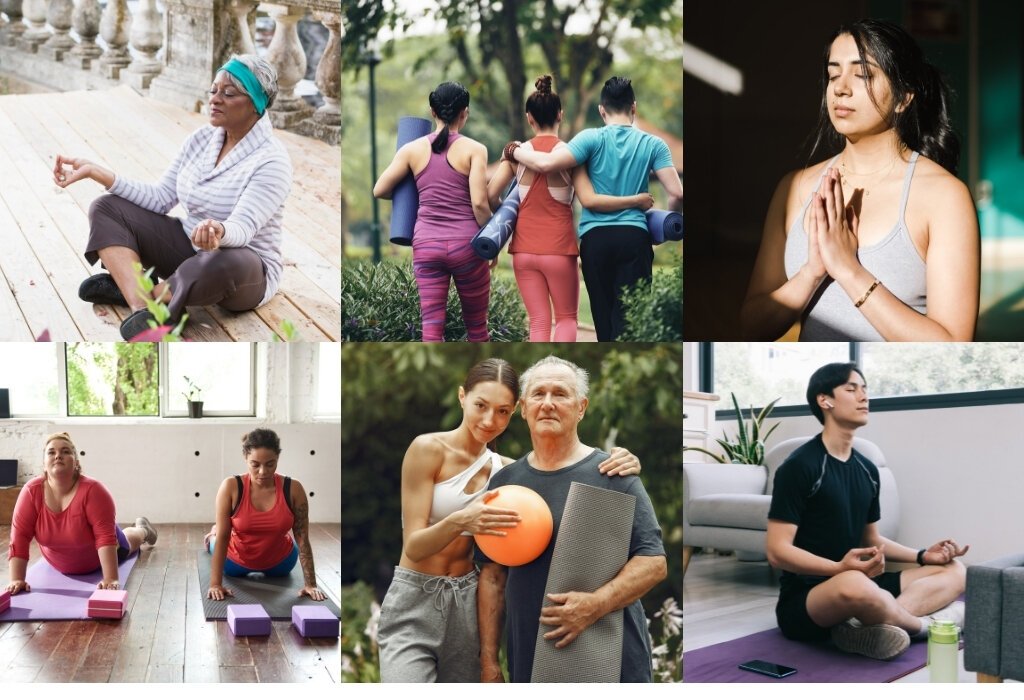Yoga And Inclusivity Beyond Body Diversity
When we talk about inclusivity in yoga, the topic often leads to body diversity, physical ability, and injuries. A major focus is on a bounded language of encouragement, where positive affirmation is given in the form of physical appearance. Your stomach is already looking more firm. You are doing great, you will have a tight butt in no time. The language revolved around a certain accepted notion of a body.
The other focus is on the pressure put on perfecting a pose. With different bodies having varied physical attributes, there seems to be a lack of modifications or alternate poses in today’s yoga practice. There is more emphasis on getting a practitioner to achieve a certain pose, instead of helping to work on improving their physical limitations. A sort of yoga ableism is inherently accepted. There are numerous articles exploring each of these issues in-depth.
Though these are very relevant and important issues, the subject of inclusivity in yoga often forgets gender, sexuality, ethnicity, economic status, and age. At Yogahub, we want to break down these barriers of inequality placed on yoga practitioners. We wanted to start by understanding the disparities in each group.
1. Gender
On the surface level, statistics show that between 2012 and 2016, the number of men practicing yoga increased by 150%. That sounds like a great number. But it doesn’t factor in the increased popularity and exponential growth of yoga as a whole. Even with more men, 76% of all yoga practitioners are women. This is partly due to misinformation and partly the marketing efforts of yoga apparel manufacturers.
Yoga is widely thought to help improve flexibility and mindfulness. What people often miss out on is its strength aspect. Yoga uses one's own body weight and resistance to build muscles and improve the overall strength of one's body.
When the boom in yoga occurred, apparel companies capitalized on it, by creating premium products catered specifically to it. The easiest target market to acquire were women, as they already paid a premium on everyday products and on average spent more money than men on clothing. With multiple ads, campaigns, and endorsements for yoga-wear for women, yoga as a whole started to take shape as an exercise meant for women in people’s minds.
2. Sexuality
There aren’t extensive studies done on the correlation of yoga and sexuality, but one study found lesbian women practiced yoga at much lower rates than their heterosexual counterparts. A major reason for this being, they felt unwelcomed. As they did not see people like them, they assumed there was no place for them.
This is where openly encouraging diversity comes into play. Speak to people of different sexualities in your marketing. Show same-sex couples practicing in your advertising. Or simply have a sign or insignia that makes them feel welcome at your place of practice.
3. Economic Status
Not always, but often, education is linked to economic status. The median income of a person with a college degree is higher than that of someone without. A study by NHIS found that over half of yoga practitioners had a college degree, putting them in a higher socioeconomic status. This does not mean yoga is reserved for people with a higher education level. On the contrary, people with more access to resources are able to seek out information about yoga and understand its advantages.
Most benefits of yoga are geared towards people with desk jobs, who are at the computer a lot. Their availability before 9 and after 5 is taken as a standard. But what about blue-collar workers with erratic schedules or people working more than one job. More often than not these groups aren’t catered or advertised to. It is time we make a concise effort to extend our inclusivity to accommodate people who do not have a standard 9-5 work schedule.
4. Ethnicity
Yoga is widely viewed as a positive practice that helps practitioners improve their mental and physical wellness. So it came as a surprise when a study by NHIS found that yoga is negatively related to being black and positively related to being white. It is tough to understand why such a perception exists making it hard to combat. It isn’t like yoga is for any ethnicity to claim. It is a global practice that has existed for over 5000 years.
A quick google search of yoga poses or yogis will explain this disparity in perception. It is hard to find a dark-skinned person in the search. When people don’t see others like themselves, they start to assume it isn’t something that is meant for them. This can be changed by actively showing darker-skinned people practice yoga in advertising. Having outdoor classes where they can see people like themselves practicing. Actively promoting more ethnic diversity in the yoga teaches you choose to hire.
5. Age
Though yoga is preferred by middle-aged people we fail to realize by how much. Over 50% of yoga practitioners are between the ages of 30 and 49. So why are the people younger than 30 and older than 49 not as actively engaged with practicing yoga?
For the 49+ community, it is a matter of modifications. A lot of them aren’t at their physical peak or may have a sustained injury. With an increase in lack of modifications and substitutions in poses, it becomes difficult for them to justify paying for a class when they can not reap its benefits.
On the younger side, yoga isn’t seen as taxing enough. Yes, yoga offers mindfulness and physical wellness, but it doesn’t make promises of a six-pack or a beach body, which is what they are looking for. It is more intense workouts with quick gains. In their eyes, yoga is generally seen as a continuous long-term practice for ready improvement and personal growth.
In Conclusion
The last year has been about adapting to an environment that we could not have predicted. Keeping up with the changes and pivoting the corporate wellness industry as a whole. But this coming year is all about preparedness. We know what is going to happen and how the wellness landscape is set to change again. So we have to be ahead of the curve instead of reacting to the changes as we strive to bring wellness to everyone.


